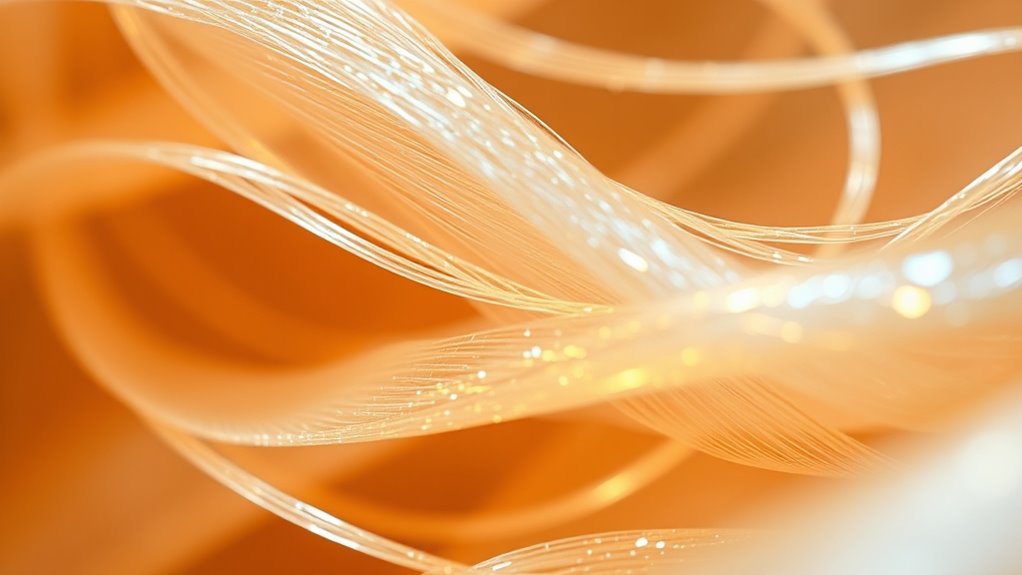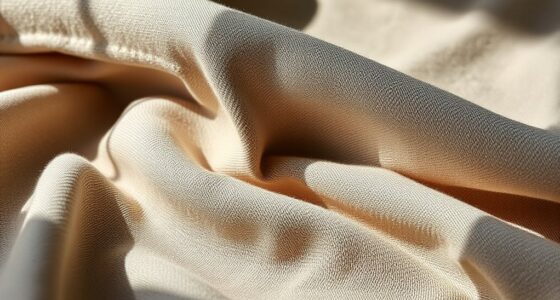The luster of silk comes from its microscopic fiber structure and surface chemistry, which work together to manipulate light perfectly. Its smooth, aligned fibroin filaments reflect light evenly, creating that signature shine. The surface contains specific chemical groups that enhance reflection and refract light to boost brilliance. This harmony between microscopic arrangement and chemistry explains silk’s unmatched glow. Exploring these secrets reveals how tiny details give silk its luxurious appeal—there’s more to uncover behind its shimmering beauty.
Key Takeaways
- Microscopy reveals silk’s hierarchical fiber structure, with aligned fibroin filaments that optimize light reflection.
- The smooth, uniform surface minimizes irregularities, enhancing silk’s natural shine under microscopic inspection.
- Surface chemistry, including amino acid groups, influences how silk interacts with light to produce luster.
- Internal fiber arrangement and surface chemistry work together to create silk’s distinctive optical brilliance.
- Microscopic analysis explains silk’s shimmering appearance, highlighting the importance of structural and chemical precision.

Silk’s shimmering luster has captivated people for centuries, but the secret lies in its microscopic structure. When you examine silk under a microscope, you discover a complex yet elegant arrangement of fibers that play a vital role in its radiant appearance. The fiber structure of silk is composed of long, smooth proteins called fibroin, which are spun into thin, uniform filaments. These filaments are tightly packed and aligned in a way that minimizes surface irregularities, allowing light to reflect evenly. The smoothness of the fiber surface enhances the silk’s natural shine, giving it that characteristic glow that’s hard to replicate. You might notice that the fibers aren’t just random threads; they’re meticulously organized, with a hierarchical structure that contributes to silk’s strength and luster. This microscopic arrangement is crucial for understanding why silk exhibits such remarkable optical properties. Surface chemistry is another key factor behind silk’s luminous quality. At a microscopic level, the surface of silk fibers is coated with specific chemical groups that influence how light interacts with them. The protein molecules on the surface contain amino acids with various functional groups, such as hydroxyl, amino, and carboxyl groups. These groups create a surface that’s both hydrophilic and capable of forming hydrogen bonds, which stabilize the fiber’s structure while also affecting its optical properties. The way these chemical groups interact with light causes the silk to reflect and refract light in a manner that enhances its natural sheen. This surface chemistry is finely tuned; even minor variations can markedly impact the way silk looks and feels. When you combine the fiber’s internal structure with its surface chemistry, you get a fabric that’s not only strong but also visually stunning. The microscopic alignment of fibroin fibers ensures consistent reflection, while the chemical composition of the fiber surface manipulates light to produce that alluring luster. This harmony between structure and chemistry is what makes silk unique among natural fibers. By understanding these microscopic details, scientists and textile artisans can better appreciate why silk remains a symbol of luxury and elegance. It’s not just about the quality of the material but about the intricate, microscopic secrets that give silk its unmatched shimmering beauty. Every time you admire silk’s glow, remember it’s the microscopic interplay of fiber structure and surface chemistry that truly makes it shine.
Frequently Asked Questions
How Does Silk’S Microscopic Structure Affect Its Durability?
Silk’s microscopic structure directly influences its durability through fiber strength and surface roughness. You’ll notice that its layered protein fibers create a strong, flexible network, making it resistant to tearing. Additionally, the smooth surface reduces friction and wear, enhancing longevity. By understanding these microscopic features, you see how silk’s intricate structure ensures it remains durable while maintaining its luxurious appearance and feel over time.
Can Microscopy Reveal Differences Between Natural and Synthetic Silk?
You can use microscopy to tell natural from synthetic silk by examining fiber morphology and molecular composition. Natural silk has a unique, irregular fiber structure with specific molecular patterns, while synthetic silk often shows more uniformity. By analyzing these microscopic differences, you get clear evidence of the silk’s origin, helping you distinguish between authentic natural fibers and lab-made alternatives effectively.
What Role Do Microscopic Scales Play in Silk’S Shine?
Imagine tiny mirrors on silk’s surface, reflecting light with grace. Microscopic scales influence silk’s shine by affecting fiber arrangement and surface morphology. When scales are aligned smoothly, they create a seamless surface that maximizes light reflection, enhancing luster. Conversely, irregular or rough scales scatter light, dulling the shine. So, these microscopic scales act like polished tiles, playing a vital role in silk’s unmatched brilliance.
How Does Environmental Exposure Alter Silk’S Microscopic Features?
Environmental effects can considerably impact silk’s microscopic features, leading to microscopic degradation over time. You might notice that exposure to sunlight, humidity, or pollutants causes the tiny scales and fibers to weaken or become dull. These changes alter the silk’s reflective properties, diminishing its natural luster. By understanding how environmental factors affect silk at the microscopic level, you can take steps to preserve its shine and prevent long-term damage.
Are There Specific Microscopy Techniques Best Suited for Silk Analysis?
Imagine uncovering silk’s hidden story through a lens—what microscopy techniques reveal its secrets? You’ll find that scanning electron microscopy (SEM) excels at analyzing fiber morphology, showing detailed surface structures. Confocal microscopy allows you to observe dye penetration, highlighting how dyes interact with silk fibers. These methods work together, providing a thorough view of silk’s microscopic features and helping you understand its lustrous beauty at a cellular level.
Conclusion
Now that you understand the microscopy secrets behind silk’s luster, you see it’s like a shimmering mirror, reflecting light with perfection. By revealing these tiny, intricate structures, you gain a newfound appreciation for silk’s natural beauty. It’s not just a fabric, but a masterpiece crafted by nature’s tiniest artists. Next time you touch silk, remember the microscopic wonders that make it glow—truly a marvel worth appreciating up close.










